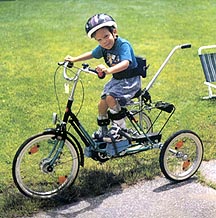ASSISTIVE TECHNOLOGY

Assistive technology for cerebral palsy encompasses many devices, with the use of which cerebral palsy patients may become more able, and can achieve greater independence. They may also be better equipped to perform at jobs. According to the Assistive Technology Act, assistive technology is any item, piece of equipment, or product system, whether acquired commercially, modified, or customized, that is used to increase, maintain, or improve the functional capabilities of individuals with disabilities.
Computer equipment (and internet access) are empowering innovations in assistive technology for cerebral palsy patients. These computers now come with ergonomic fixed or split keyboards for people with musculoskeletal problems, sophisticated scanning equipment, on-screen keyboards, head operated pointing devices, and voice recognition software. These and other technologies assist people with severe disorders due to cerebral palsy.
Portable or computer related devices that can literally "speak", are helpful to people with speech disabilities. Additional assistive technology devices for cerebral palsy include equipment such as alternative pointing devices, and switches can make it easier or possible for a person to use radios, televisions, microwaves, etc. Devices are made to assist or replace (to an extent) whichever human function is compromised in the person. There are hearing aids and other amplification devices for individuals with hearing loss. For those who are blind or have reduced vision, there are refreshable braille displays, braille embossers, portable closed circuit TVs that magnify text or color images 5 to 15 times, screen reader softwares that provides visual information in audio format, and telecommunication devices that allow a deaf person to converse via the telephone. Assistive technology that is very basic in nature includes grab bars in toilets and showers equipped for people to balance themselves. The hi-tech devices include computer boards attached to electronic wheelchairs that allow a person with severe cerebral palsy related problems to both travel in the outside world and engage it with meaningful words and speech.
Computer equipment (and internet access) are empowering innovations in assistive technology for cerebral palsy patients. These computers now come with ergonomic fixed or split keyboards for people with musculoskeletal problems, sophisticated scanning equipment, on-screen keyboards, head operated pointing devices, and voice recognition software. These and other technologies assist people with severe disorders due to cerebral palsy.
Portable or computer related devices that can literally "speak", are helpful to people with speech disabilities. Additional assistive technology devices for cerebral palsy include equipment such as alternative pointing devices, and switches can make it easier or possible for a person to use radios, televisions, microwaves, etc. Devices are made to assist or replace (to an extent) whichever human function is compromised in the person. There are hearing aids and other amplification devices for individuals with hearing loss. For those who are blind or have reduced vision, there are refreshable braille displays, braille embossers, portable closed circuit TVs that magnify text or color images 5 to 15 times, screen reader softwares that provides visual information in audio format, and telecommunication devices that allow a deaf person to converse via the telephone. Assistive technology that is very basic in nature includes grab bars in toilets and showers equipped for people to balance themselves. The hi-tech devices include computer boards attached to electronic wheelchairs that allow a person with severe cerebral palsy related problems to both travel in the outside world and engage it with meaningful words and speech.
| assistive_technology.wma |
Source:
K, M. (2009). Assistive Technology for Cerebral Palsy. Retrieved June 24, 2010, from Buzzle: http://www.buzzle.com/articles/assistive-technology-for-cerebral-palsy.html
